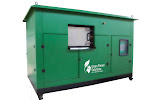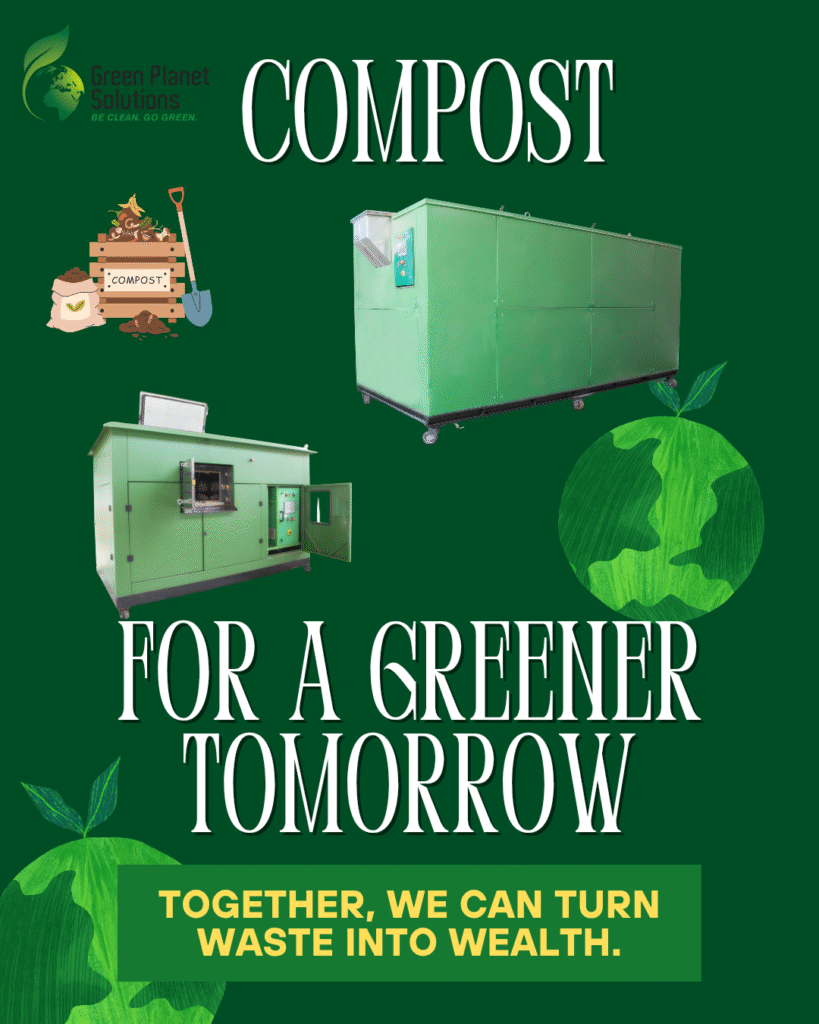ENQUIRE NOW FOR BEST COMPOSTING MACHINES IN INDIA – https://share.hsforms.com/1d12AT_oJScm8iiXbjSrEIwrh2r7
Introduction
Organic (wet) waste is the single largest component of municipal solid waste across India. When managed correctly it becomes a resource — compost, soil amendment and biogas feedstock. When mismanaged it generates methane in landfills, fouls drains, and increases disposal costs. Recent policy pushes, pilot projects and rising demand from farmers and landscapers mean the time to act is now. Municipalities that get wet-waste management right can reduce greenhouse gases, cut landfill dependency, save on transport, and create local economic value. This article maps demonstrated progress, highlights recurring implementation gaps, and provides a practical, 12–18 month roadmap municipal leaders and service providers can use to scale effective composting programs.

1) Where India stands — progress at a glance
Policy & national direction
Over the last decade central and state authorities have emphasized source segregation, decentralized processing and market development for city compost. Policies and schemes now encourage ULBs (Urban Local Bodies) to treat wet waste close to the source, pilot modular technologies, and connect compost output to buyers.
Growing number of pilots & models
Several cities and municipal markets have successfully piloted decentralized solutions — from community windrows and market-level composters to in-vessel rapid machines and hybrid systems that combine anaerobic digestion + composting. These pilots demonstrate that with the right mix of technical design, vendor oversight and community participation, wet waste can be diverted at scale.
Emerging market linkages
Demand is rising from peri-urban farmers, landscapers, and municipal urban forestry teams for good-quality compost. A few municipalities have started branding and selling “city compost” to local users, creating revenue streams that improve project viability.
ENQUIRE NOW FOR BEST COMPOSTING MACHINES IN INDIA – https://share.hsforms.com/1d12AT_oJScm8iiXbjSrEIwrh2r7
Even with progress, several stubborn gaps stop scale-up:
A. Poor source segregation → contamination
Mixed waste (plastics, food packaging) remains the primary issue. Contamination raises processing costs and lowers compost quality. Without consistent door-to-door segregation, composting units receive feedstock that needs extra preprocessing—adding O&M costs.
B. Under-deployment of decentralized infrastructure
Many ULBs still centralize processing in a few large facilities far from waste generation points. High transport costs and time delays reduce the environmental benefit. Decentralized, modular units at market clusters or ward level are underused.
C. Weak quality assurance & standards
Compost quality varies widely. Lack of standard testing protocols and certification reduces farmer confidence, making it hard to create reliable demand and price points.

D. Fragile finance & revenue models
Operational budgets, payments to contractors, O&M costs and market uncertainty make projects financially fragile. Subsidies help but are often inadequate or unevenly applied. Many projects fail to close the loop to buyers or to monetize environmental benefits.
E. Capacity and governance shortfalls
ULB teams frequently lack training in operations, compost science, contract enforcement and community engagement. Contracts with service providers often emphasise equipment supply but not sustained performance metrics.
F. Logistics & behaviour barriers
Collection route optimisation, timely pick-ups, and community participation (especially in high-rise and gated communities) remain operational headaches. Behaviour change is slow without continued awareness and incentives.
ENQUIRE NOW FOR BEST COMPOSTING MACHINES IN INDIA – https://share.hsforms.com/1d12AT_oJScm8iiXbjSrEIwrh2r7
To overcome the gaps, combine technical fixes with governance, finance and market measures.
1. Aggressively prioritise source segregation
- Launch simple, visible campaigns: doorstep calendars, colour-coded bins, local champions.
- Pair awareness with enforcement & incentives: small fee discounts, recognition for compliant RWAs/wards.
- Use segregation ambassadors in markets and high-footfall areas.
2. Deploy decentralized, modular processing where waste is generated
- Fit smaller market/ward-level units (windrows, in-vessel, or rapid composters) sized to local throughput.
- Reduce transport distance, and avoid overloading central plants.
- Use hybrid models: smaller units for pre-processing + central plant for maturation and quality control.
ENQUIRE NOW FOR BEST COMPOSTING MACHINES IN INDIA – https://share.hsforms.com/1d12AT_oJScm8iiXbjSrEIwrh2r7
3. Standardise quality & build buyer confidence
- Adopt clear QA parameters (C:N ratio, pathogen reduction, heavy-metal limits) and publish results.
- Offer third-party testing and simple “City Compost Certified” labelling.
- Run demonstration plots with local farmers to show agronomic benefits.
4. Create robust finance models
- Layer funding: central/state capital subsidies + O&M revenue from compost sales + service fees + performance-linked payments to operators.
- Explore aggregator models where several wards feed a larger marketable output.
- Pilot revenue diversification: branded compost packs for landscapers, carbon credits, compost subscription programs for corporates.
5. Strengthen contract management & capacity building
- Use performance-based contracts (deliverables, quality metrics, uptime).
- Train ULB staff in monitoring, odour control, and basic compost science.
- Build local vendor markets for O&M and spare parts.
6. Use tech & analytics to improve logistics
- IoT sensors for bin fill levels, route optimisation apps, dashboards for operations & complaint tracking.
- Simple mobile apps for citizen pickup requests and market communication.
ENQUIRE NOW FOR BEST COMPOSTING MACHINES IN INDIA – https://share.hsforms.com/1d12AT_oJScm8iiXbjSrEIwrh2r7
Phase 0 — Preparation (0–2 months)
- Conduct a waste characterisation and baseline study.
- Identify 1–3 pilot wards/markets with willing stakeholders.
- Map farmer/landscaper demand and potential buyers.
Phase 1 — Pilot implementation (2–9 months)
- Start door-to-door segregation campaigns in pilot wards.
- Deploy 1–2 modular compost units in markets/wards.
- Implement simple QA testing and brand first output.
- Run farmer demo plots and gather agronomic data.
Phase 2 — Scale & refine (9–18 months)
- Expand to additional wards; add collection routes and modular units.
- Formalise buyer agreements and pricing.
- Migrate to performance-based contracts for operators.
- Introduce revenue streams (bagged compost sales, municipal landscaping procurement, carbon/ESG credits).
Quick wins (within 3 months)
- Start segregation in one market, install pre-processing bins, and run a farmer demo with 100–500 kg compost.
Green Planet Solutions Pune supports ULBs, market committees, RWAs and corporates with end-to-end implementation:
- Waste characterisation & feasibility studies
- Design, supply & commissioning of modular composting systems (windrow, in-vessel, rapid units)
- O&M, training, and contract monitoring services
- Compost quality testing, certification assistance & market development
- Pilot programs: 30-day pilot offer (collection optimisation + small on-site composter + farmer demo)
Pilot offer: Limited slots—includes baseline study, one modular unit on a trial basis, QA report and farmer demo. Contact us to apply for the pilot.
Target audience: Municipal commissioners, waste managers, market committees, RWAs, sustainability officers, CSR teams, compost machine vendors, farmers/aggregators.
Primary keywords (high intent):
- wet waste management India
- city composting solutions
- municipal composting India
- decentralized composting units
Secondary keywords (informational):
- source segregation best practices India
- market composting model
- compost quality standards India
Long-tail keywords / FAQs:
- how to set up modular composting unit in Indian market
- city compost certification for farmers
- pilot composting program municipal ward checklist
On-page recommendations:
- H1 contains primary keyword; include local city names for geo-targeting (e.g., Pune, Mysuru case study).
- Add FAQ schema (Q/As about percentage organic waste, safety, cost).
- Offer gated lead magnet: “Municipal Composting Checklist + ROI Calculator” to capture emails (role + city).
Common words (readability): compost, waste, municipal, market, farmer, collection, segregation, bin, plant, quality.
Uncommon / technical words (authority): windrow, in-vessel, C:N ratio, pathogen reduction, biomethanation, market development assistance.
Power words (CTAs & headlines): transform, scale, proven, certified, unlock, accelerate, pilot, guarantee.
Emotional words (use sparingly in narratives): relief, pride, responsibility, urgency, confidence, opportunity, hope.
- Top CTA (visible): Download the “Municipal Composting Checklist + ROI Calculator” (gated: name, email, organisation, city).
- Mid-article CTA: Book a free 30-minute feasibility call for your ward/market.
- Bottom CTA: Apply for a 30-day pilot (limited slots) — Green Planet Solutions Pune.
- Lead magnets: Checklist, 1-page O&M template, compost quality testing voucher, short case study PDF.
LinkedIn post:
“Wet waste is India’s single biggest opportunity to cut landfill emissions and create value. Our 12–18 month roadmap helps ULBs go from pilot to scale — with modular processing, QA, and market linkages. Download the Municipal Composting Checklist. #CityCompost #WetWasteManagement #CircularEconomy #GreenPlanetSolutions”
“Turn market waste into compost — 3 quick wins for municipalities: segregation, decentralised processing, & farmer demos. #WasteToResource #CityCompost”
#WetWaste #CityCompost #WasteManagementIndia #CircularEconomy #Composting #UrbanSustainability #GreenPlanetSolutions #MunicipalSolutions #ZeroWasteIndia #ClimateAction
Q: What percentage of municipal waste in India is organic?
A: The organic (wet) fraction often ranges from ~30% to 70% depending on the city and season; it is typically the largest component and the highest-impact stream to manage first.
Q: Is city compost safe for agriculture?
A: Yes—when produced under controlled processes, tested for contaminants and pathogens, and certified to quality standards, city compost is a valuable soil amendment. Quality control is critical.
Q: How much space does a modular composter need?
A: Modular units vary widely. Small market/ward units can fit in 10–50 m², while larger in-vessel systems require more space. Feasibility depends on daily throughput and local constraints.
Q: How can municipalities make composting financially viable?
A: Combine capital subsidies, output-linked market assistance, branded compost sales, service fees, and explore carbon/ESG credits—plus efficient O&M to lower costs.
Wet waste is an economic and environmental opportunity—get the basics right (segregation, decentralised processing, QA and market linkages) and your city can turn waste into wealth. Green Planet Solutions Pune is ready to help design pilots and scale proven models.

– https://www.thegreenplanetsolutions.com/
 – +917722073961
– +917722073961
Instagram – https://www.instagram.com/greenplanetolutions2013?igsh=MTQ5MWxpeng5dmtvaA==
Facebook – https://www.facebook.com/share/19Eim5u2Ep/
Linkdein – https://www.linkedin.com/company/green-planet-solutions/
Threads – https://www.threads.net/@greenplanetolutions2013
YouTube – https://youtube.com/@greenplanetsolutions2013?si=0gkKEahaaB5z6csm
Leave a Reply